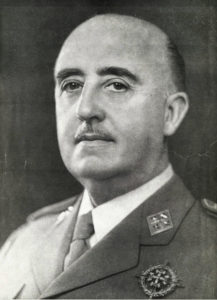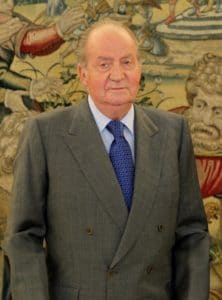
The civil war was viciously fought and there were many atrocities committed by all sides. The war claimed the lives of over 500,000 people and caused the flight of up to a half-million citizens from the country. On 1 April 1939, five months before the beginning of World War II, the rebel side led by Franco emerged victorious, imposing a dictatorship over the whole country.
The regime remained chiefly “neutral” from a nominal standpoint in the Second World War, although it was sympathetic to the Axis and provided the Nazi Wehrmacht with Spanish volunteers in the Eastern Front.
After World War II Spain was politically and economically isolated, and was kept out of the United Nations. This changed in 1955, during the Cold War period, when it became strategically important for the US to establish a military presence on the Iberian Peninsula as a counter to any possible move by the Soviet Union into the Mediterranean basin. In the 1960s, Spain registered an unprecedented rate of economic growth which was propelled by industrialization, a mass internal migration from rural areas to Madrid, Barcelona and the Basque Country and the creation of a mass tourism industry. Franco’s rule was also characterized by authoritarianism, promotion of a unitary national identity, National Catholicism, and discriminatory language policies.
Restoration of Democracy:
In 1962, a group of politicians involved in the opposition to Franco’s regime inside the country and in exile met in the congress of the European Movement in Munich, where they made a resolution in favor of democracy.
With Franco’s death in November 1975, Juan Carlos succeeded to the position of King of Spain and head of state in accordance with the franquist law. With the approval of the new Spanish Constitution of 1978 and the restoration of democracy, the State devolved much authority to the regions and created an internal organization based on autonomous communities. The Spanish 1977 Amnesty Law let people of Franco’s regime continue inside institutions without consequences, even perpetrators of some crimes during transition to democracy like the Massacre of 3 March 1976 in Vitoria or 1977 Massacre of Atocha.

In the Basque Country, moderate Basque nationalism coexisted with a radical nationalist movement led by the armed organization ETA until the latter’s dissolution in May 2018. The group was formed in 1959 during Franco’s rule but had continued to wage its violent campaign even after the restoration of democracy and the return of a large measure of regional autonomy.
On 23 February 1981, rebel elements among the security forces seized the Cortes in an attempt to impose a military-backed government. King Juan Carlos took personal command of the military and successfully ordered the coup plotters, via national television, to surrender.
During the 1980s the democratic restoration made possible a growing open society. New cultural movements based on freedom appeared, like La Movida Madrileña and a culture of human rights arose with Gregorio Peces-Barba. On 30 May 1982 Spain joined NATO, followed by a referendum after a strong social opposition. That year the Spanish Socialist Workers Party (PSOE) came to power, the first left-wing government in 43 years. In 1986 Spain joined the European Economic Community, which later became the European Union.
